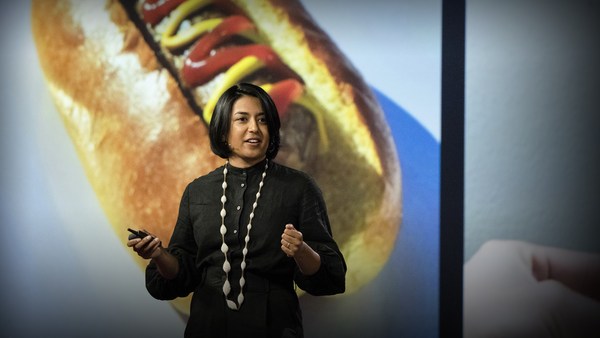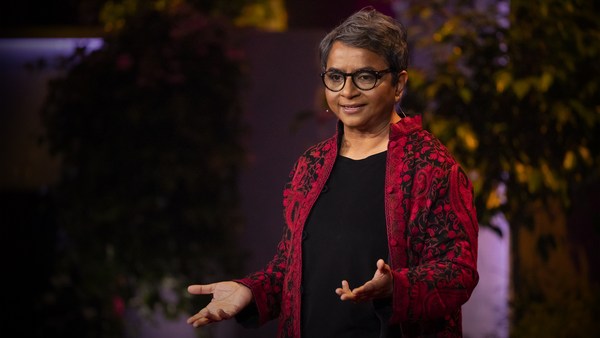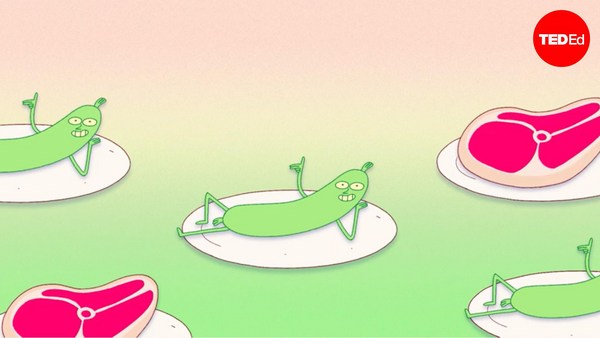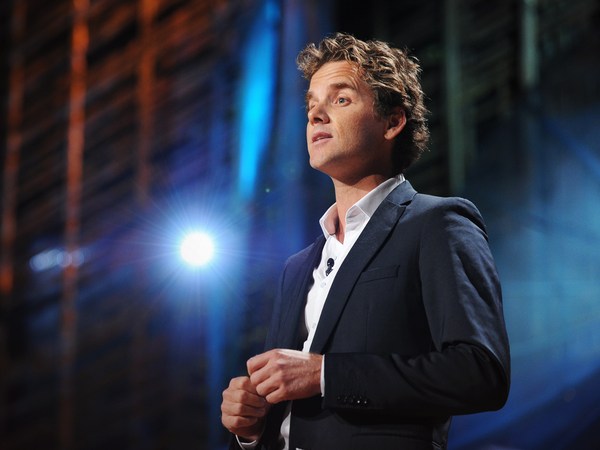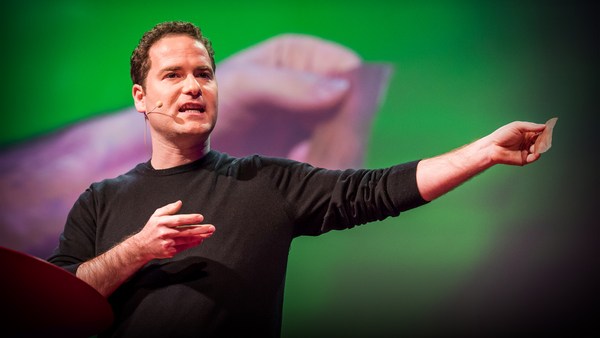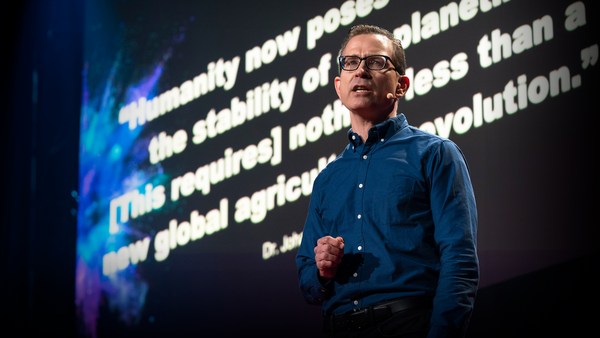I was 12 years old when I came face-to-face with the paradox of meat. I was at my friend's birthday party. There was a lot of fun, music, celebration and games in the front of the house. So I ran into the backyard looking for more fun. And what I stumbled upon shocked me. There were people slaughtering frightened animals for the birthday feast.
This was a strange feeling. As a 12-year-old kid, seeing intense suffering in the back and sheer joy in the front, juxtaposing a birthday with a death day all in the same instance was too much to handle. The 12-year-old me broke down into tears. I know this is a common experience for many of you, and probably many of your children.
We all know at some level that the meat that we eat today has a really troubling story behind it. We know that billions of animals are raised in painful, overcrowded conditions and not in the idyllic pastures that we'd like to believe in. We know that climate change is caused -- a leading cause for it, in fact, is meat production. We also know that factory farming is responsible for the spread of incredibly scary diseases, and also to the rising antibiotic resistance.
But despite all of this, you probably will continue to eat meat. In fact, the world is going to eat twice the amount of meat in the first half of this century than when we started. So despite all of this, why? Why is the question. Do we really have a solution for it? I'm not sure yet.
But I'll tell you why this is a complex question to answer, because meat is the most incredibly delicious food that we've gotten used to. No disrespect to salads or beans. It's been part of our culture, traditions and religion for hundreds, if not thousands of years. We love the product, not so much the process. So we've learned to ignore the conflict by simply turning a blind eye. And I think this is the central conflict that a conflicted carnivore deals with.
So is there a way out for a conflicted carnivore? I believe there is. In fact, I am betting on it. About eight years ago, I quit my job as a cardiologist and moved my family across the country to start a team solely focused on working on solving this problem.
I cofounded a company called UPSIDE Foods to work on a crazy idea called cultivated meat. It's based on a simple principle that all the meat we eat comes from a bunch of animal cells. So we asked the question, could we just grow the animal cells directly into meat without having to raise the animal?
And it turns out that this idea was rooted in science fiction for many, many decades. And I want to show you and illustrate to you how we can do this with chicken.
So let's start off with a chicken or an egg. What we do is we take a small sample of cells from the egg or the chicken, and we identify the cells that are high-quality and continue to grow outside the animal into chicken meat. Once we have the right cells, we save them for later or when we want to make chicken, we pull them out in a small sample just like the one that will fit in a vial like this.
Inside this vial you could expect to see millions of cells just like the ones you're seeing on the slide. Now remember, the life of a chicken started with a single cell that grew and multiplied into millions and billions of cells.
So we take these cells and put them in a cultivator. You might ask, what is a cultivator? A cultivator is nothing but a clean vessel that provides a safe and nurturing and warm environment for the cells to grow into chicken meat. They can come in a small size, like the size of a water bottle, or they could be as tall as one to two stories, steel, clean, gleaming tanks like the one you're seeing behind me.
Once we grow this meat for about two weeks, we are ready to harvest it and shape it into the products that we love. Whole cut products or cut products. And it's common to mix some of these products with plant-based fibers to add texture. This can be done with beef, salmon, duck, or any species that you can imagine.
And once we have the cells we want, we do not have to go back to the animal. In fact, the cells we've been using to grow chicken, we've taken them from an egg in 2018, and for six years we haven't had to go back to the animal again.
It's a kinder way to make meat, but it's also kinder to the environment. A number of studies are showing, for instance, for cultivated beef, when grown at scale, using renewable energy, has a 90 percent lower greenhouse gas emissions, 90 percent lower land use and lower pollution. It's also cleaner in the absence of animal waste or the need to use antibiotics that increase the risk of infections, whether it's E-coli or salmonella. We can have really clean conditions for manufacturing.
Now, I think you're certainly thinking that this is science fiction for sure, this is crazy, but eight years ago, when I started UPSIDE Foods, a number of people laughed at me and our team. Let me show you the rapid progress that's happened in the last eight years.
In 2016, we showed the world the first cultivated beef meatball and followed that up in 2017 by showing the first ever cultivated duck or chicken. This proved science. This was proof of science for multiple species over a few years. So what's next?
The most important thing next was to prove safety. We started working with the top two regulators in the United States, the FDA and the USDA, and over multiple years, and after thorough examinations of our process, we got the green light to release our products into the market less than a year ago, in July 2023.
I have to tell you, the next part of this is the consumer. You might ask, how does it taste? The faces of these people, hardcore meat eaters and vegetarians alike, will tell you the story that this is delicious. In fact, our favorite quote is from “The Washington Post,” where the James Beard Award-winning writer wrote that "this was the most chickeny chicken" he's tasted in a long time.
Alright, so speaking of delicious, our chef here has been busy cooking some of the products that I want to show to you. Let me show or illustrate how this could work in your life.
Imagine a week. It starts off with a Sunday, and your kids want you to cook breakfast. And their favorite breakfast is a breakfast sausage. Let me show you how that could look.
Thank you. David.
OK, for instance, there's a cultivated chicken breakfast sausage. It's delicious, it's juicy. I want to eat it right now. But there's more.
I want you to think about Wednesday. You're on a work trip and you want to get a quick power lunch. Imagine this. A protein-packed chicken salad that has delicious golden brown chicken on it. And I want to eat this, too. But there's more.
(Laughter)
Now it's Friday, end of the week, thank God. And you want to go to a really relaxing and romantic dinner with your partner. And you want to impress your partner by taking your partner to the restaurant closest to you and asking for the best thing on the menu, that shows what a great person you are.
(Laughter)
And we have that for you too.
Thank you, David.
So this is a delicious chicken breast, tender and juicy and cooked in front of you, sizzling on the plate. And your partner takes a bite. And says, "Hmm."
(Laughter)
"The most chickeny chicken I've ever had."
(Laughter)
Alright, so what comes next? This industry is growing rapidly. I'm really thrilled to see there is about 170 companies in this space in every continent except Antarctica. And multiple research organizations, like the Good Food Institute, working on making this available and building training programs at the universities. We've got multiple countries giving regulatory approvals: the United States, Singapore, Israel and soon to be also Australia. We've got three billion dollars being put to work.
And hear this, South Korea has just started a free economic zone to encourage cultivated meat to be commercialized rapidly and China has added this to their five-year plan.
There are a number of companies across the world ready to bring delicious products to the market. And just look at this. They could be whole-cut products, they could be steaks, they could be beloved foods like hot dogs, burgers or sushi. Folks, there is a global race and never in history has an idea of this magnitude moved from an idea stage to this level of interest in a span of less than a decade.
So what comes next? The next step is proof of scale. We have to work and see if the industry can scale to meet the size of the problem we're trying to go after. This means we'll have to build much larger, bigger, more efficient manufacturing facilities and supply chains. We've already lowered the cost by 100-fold, but teams across the world are working relentlessly to lower the cost even further.
This is an example of our production facility that was built in California during COVID, where we've been producing cultivated meat regularly for the last 12 to 18 months, and improving operations and designs to make it a blueprint for much larger production facilities. And we've released all of this across openly for the world to see. And I think more and more of this is needed.
So what other challenges exist? Timelines are hard to predict. Regulatory approvals are hard to predict, but I believe multiple companies will be available in restaurants serving their products in the next few years, and then next five to 10 years, these should be available widely in retail. Continuing to lower costs further does not come easily. There is also hurdles related to making meat that's not just less bad, but I'm really excited about walking the path of making meat that is more good.
For example, as a cardiologist, nothing gets me more excited than opening the path of meat to be more tastier and healthier. Imagine, steak with a nutritional profile of a salmon. I think that's the future that I'm very excited about.
But our challenges are not just technological or manufacturing challenges or funding challenges. There are also social and political challenges. Florida just banned and criminalized cultivated meat production last month. Alabama is doing it as of October this year and Italy earlier this year. All in an attempt to protect an age-old industry from competition.
But I truly believe people, businesses and communities in these places will benefit from cultivated meat as well as the rest of the world. So this is no idealistic fantasy.
Throughout history, transformative innovations have always triumphed over deep, entrenched opposition, reshaping societies for the better. This is no different. It is the indomitable spirit of the people in the arena that will be foundational to push this innovation through.
But we can't do it alone. We'll need a lot of people, cheerleaders, politicians crossing party lines, people, businesses, investors and incumbent industry joining this work. Because investing in a critical idea like this, cultivated meat, for the future to keep all the foods we love on the table, as well as opening an enormous economic, ethical and environmental opportunity is right in front of us.
I leave you with one closing thought. I truly believe that cultivated meat offers this rare opportunity to bring people of every stripe together under the big tent, those who love meat and those who object to the slaughter of animals. Those who prize innovation and those who prize tradition. Those who love choice and those who value life. It's our chance, if you can forgive the joke, to have our chicken and eat it too.
(Laughter)
Thank you very much.
(Applause)
